Both sides of the bars: How mass incarceration punishes families
Government survey results illuminate the broader consequences of locking up people with children.
by Leah Wang, August 11, 2022
We know that family contact can help incarcerated people cope with being locked up and reduce their chances of returning to prison. Yet self-reported data from people in state prisons show just how difficult it is to communicate with loved ones, provide financial support even when legally obligated, and make decisions with and about their families. Millions of families and minor children throughout the country are punished emotionally, economically, and otherwise by a loved one’s incarceration.
The Bureau of Justice Statistics’ Survey of Prison Inmates data provide the deepest nationwide look yet at the challenges and impossibilities of parenting from prison. Conducted in 2016 but released as a limited public dataset in late 2020, the Survey asked people housed in state prisons about a wide range of topics, from their upbringing and childhood, to the offense that led to incarceration, to their life in prison.1 Here, we offer data and analysis revealing the ways in which prisons fail entire families — and society more broadly — by separating millions of children from their parents, and by enforcing harmful policies that perpetuate cycles of poverty and disadvantage.
Half of people in prison are parents to minors, leaving 1.25 million kids struggling to cope
Nearly half (47%) of the approximately 1.25 million people in state prison are parents of minor children, and about 1 in 5 (19%) of those children is age 4 or younger.2 Altogether, parents in state prison reported roughly 1.25 million minor children, meaning the number of people in state prison almost exactly mirrors the number of impacted minor children. Research indicates that children of incarcerated parents face formidable cognitive and health-related challenges throughout their development.
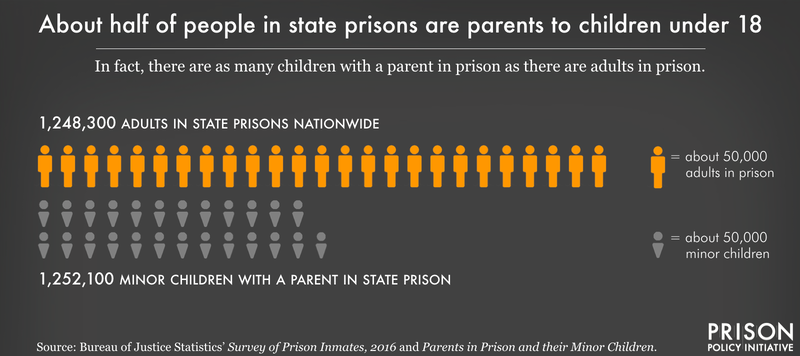
The challenges of parenting from prison are particularly likely to affect women. The Survey reveals that women in state prisons are more likely than men to be a parent of a minor child (58% of women, compared to 46% of men). Women were also more likely to have been living with their children prior to their imprisonment: About 52% of women with minor children report living with their child(ren) at the time of their arrest, compared to 40% of men. Finally, women were more likely to lead a single-parent household, as 39% of incarcerated mothers of minors lived with children but no spouse, compared to 21% of fathers.
And like the state prison population overall, incarcerated parents themselves grew up in struggling households:
- 17% spent time in foster care;
- 43% came from families that received public assistance (i.e., welfare) before they turned 18;
- 19% lived in public housing before they turned 18;
- 11% were homeless at some point before age 18; and
- 32% had (or currently have) an incarcerated parent of their own.3
Many children are uprooted by a parent’s arrest and incarceration
What happens to children when the parent they live with goes to state prison? Most go on to live with other family members: Incarcerated parents who lived with their minor children at the time of their arrest report that their child (or children) is now in the care of the other parent or step-parent (71%), a grandmother (13%) and/or grandfather (4%), or other relatives (5%). Still, other children have been moved into the homes of friends, an “agency or institution,” someone else, or they live on their own (about 4% in all).4
A small percentage of these parents (0.3%) reported that their child is currently incarcerated.5 While certainly not all children who experience parental incarceration are destined to become incarcerated themselves, the arrest and incarceration of a parent is a painful experience, and has been linked to a child’s own, eventual justice system involvement. The Survey result is too small to break down by gender or race, but research suggests that children of incarcerated mothers are more likely to become incarcerated compared to children of incarcerated fathers.
About 3,400 parents (1.8% of parents living with their minor children before arrest) report that their minor children ended up in the foster care system (separate from the “agency or institution” outcome above). This outcome, in particular, can mean an end to parental rights altogether: 1 in 8 incarcerated parents with children in foster care have their parental rights terminated, according to a Marshall Project analysis of government data.6
Currently, federal policy regarding foster children fails to acknowledge the realities of mass incarceration and long prison sentences,7 and makes it likely for incarcerated people with children in foster care to lose them permanently. For children, placement in foster care can lead more easily to criminal legal involvement, particularly those in group homes or who experience multiple moves as a foster child. In one study, by the age of 17, more than one-half of all foster care youths (not just those with an incarcerated parent) had experienced an arrest, conviction, or overnight stay in a correctional facility.
The deep despair felt by both parent and child amounts to a colossal but largely invisible crisis: the mass punishment of over 1 million children. Short of the parent being released from prison and being offered needed supports, one of the best ways to mitigate these negative impacts is by limiting barriers to meaningful contact between children and incarcerated parents.
Most incarcerated parents and their children find ways to stay in touch, but prisons make family contact difficult
Many children want, and all children deserve, the opportunity to visit their incarcerated parents. Yet two-thirds of parents in prison with minor children have never received a visit from them. Not only are many prison visitation policies excessively strict, such as onerous pre-approval processes and rules about what visitors can wear,8 but many parents are simply incarcerated too far from home for visits to be logistically or economically feasible. A national survey in 2004 revealed that almost two-thirds of people in state prisons were located more than 100 miles from home, and more than 10% were over 500 miles away, and distance is a strong predictor of receiving visits.
This most recent Survey did not ask about physical distance from home to prison, but it did ask parents about why they thought their children had not visited. Among parents in prison who had children under 18, but had not received a visit:
- The most common reason for not receiving a visit, reported by 33% of parents who had not received a visit, was that their child lives too far away.
- About one-fourth (23%) of parents responded that the child’s non-incarcerated parent or guardian did not want the child to visit. This reluctance could stem from a wish to protect the child — it can be painful to witness a parent in prison — but it could also have to do with distance, logistics, strained relationships between the adults, or cost.
- A smaller share of parents (14%) said they did not want their child to visit, possibly for some of the same reasons. Even though research shows positive impacts of parent-child contact during incarceration, it’s understandable that an adult might want to keep a child away from the prison setting.
- Just 3% of parents reported that it’s the child themselves who is reluctant to visit, signaling that most children do want to maintain a connection with their parent.
Despite these challenges, one-third (33%) of parents in prison with minor children have received at least one visit from their child. Prison policies or resources likely play a role in low levels of in-person visitation, such as a lack of visitation assistance (providing transportation to and from prisons), or eliminating visitation altogether — sometimes justifying these restrictions by exaggerating the volume of contraband items that come in through visitors.
Of course, parents in state prison and their children keep in touch in other ways: 60% of parents report phone calls with their kids, and 70% of parents send their children physical mail. (Some of this correspondence appears to be one-sided, however: only 57% report receiving mail from their children.) A smaller number of parents also report sending (10%) or receiving (13%) email from their children via computers or tablets available in prisons, indicating that more modern avenues for communication are available to some incarcerated people.
These remote (rather than in-person) connections happen more frequently than visits. Over two-thirds (72%) of phone calls, and more than one-third (35%) of incoming mail from children, are received daily or weekly, but only one-fifth (20%) of visits happen that often. Still, phone calls, mail, and email are subject to all manner of exploitation by the private companies that run prison communications. Further, prison administrations can change snail mail policies at the drop of a hat, increasingly toward “mail scanning” schemes that reduce sentimental letters and art into blurry scans — that is, if they’re delivered at all.
Child support debt follows parents into prison, despite the impossibility of paying it off
Parents also often enter prison with legal financial obligations to their children: More than one-fourth (27%) of parents in state prisons with minor children owe ongoing child support, and most of those (80%), unsurprisingly, owe back pay. Men are more than twice as likely to owe child support (29% of fathers, compared to 14% of mothers).
However, it’s extremely difficult for incarcerated people to fulfill this legal-financial obligation. People who enter prison are among the nation’s poorest, and even those who do work a prison job earn appallingly low wages. Knowing this, at least 13 states automatically modify child support payments when a noncustodial parent is incarcerated, according to the National Conference of State Legislatures. In other states, however, the parent must act within a narrow time window to submit payment modification paperwork, or else they may accumulate astronomical debt while incarcerated.9
If 500,000 people are released from state prisons every year — a conservative estimate10 — that means about 63,000 of them are parents saddled with this debt, reentering society with little to no savings and lower earning potential due to their criminal-legal involvement. If they manage to land a job upon release, their wages are usually garnished for child support; without employment and automatic payments, however, missing just one child support payment can thwart other reentry steps like obtaining a driver’s license, filing a tax return — and critically, even staying out of jail.
What can be done for families experiencing incarceration?
State policies fail to recognize what so many advocates, researchers, and directly impacted people already know: that state prison incarceration has devastating and far-reaching impacts on family members and entire communities. States and prisons should take steps to ease these burdens, such as making family contact easier through expanded family visitation, visitation assistance, low-cost or free phone calls, and policies that allow real, sentimental mail to be sent from child to parent. What’s more, prisons should ensure that parents are incarcerated as close as possible to their home communities, as in-person visitation may yield some of the most positive impacts on health and behavior. 11
Of course, intervention is possible much earlier than in prison: in some states, primary caregiver laws or family-based sentencing allow for diversion or other community-based alternatives to incarceration for parents or guardians. In Oregon, a family sentencing pilot program kept nearly 400 children out of the foster care system over five years, and led to lower rates of recidivism and revocation compared to similar non-program participants.
Meanwhile, incarcerated parents who maintain a role in their kids’ lives should not have their relationships permanently severed: At the federal level, Congress can repeal the Adoption and Safe Families Act, relieving states of inflexible timelines for terminating parental rights. Further, for noncustodial parents, all states should adopt automatic suspension or modification of child support payments. As we continue to tell the story of incarcerated people through findings from the Survey of Prison Inmates, these data serve as a reminder that the story also belongs to over 1 million children, countless loved ones, and whole communities left behind by harmful state policies.
Footnotes
-
You can read more about the demographic, early life, and health-related results from the survey in two of our latest reports, Beyond the Count: A deep dive into state prison populations, and Chronic Punishment: The unmet health needs of people in state prisons, and our briefing, What the Survey of Prison Inmates tells us about trans people in state prison. ↩
-
69% of people in state prison report having one or more children of any age, and 69% of those have a child under 18, equating to 47% who were parents of minor children at the time of the 2016 Survey. ↩
-
These statistics refer to incarcerated parents of any-age children, not just those of minor children. ↩
-
The 2016 Survey of Prison Inmates asked “Who do the children [that they lived with at the time of arrest] live with now?” The children only needed to be under the age of 18 before someone’s arrest that led to incarceration. Therefore, these results likely describe the current living arrangements of both minor and grown children, who experienced parental incarceration while they were a minor child. Additionally, due to a technical survey error, some parents who were eligible for this question were skipped, so these results do not represent all surveyed parents who lived with their minor children at the time of arrest. ↩
-
According to this Bureau of Justice Statistics analysis of the Survey of Prison Inmates, about 5% of people in state prison reported that a child of theirs has ever been incarcerated, regardless of living situation at the time of the respondent’s arrest. ↩
-
The Marshall Project analyzed approximately 3 million child welfare case records, created between 2008 and 2016, from the U.S. Department of Health and Human Services. They found that incarcerated women (who, according to the Survey, were almost three times as likely as men to have their child move into the foster care system) saw their rights terminated more often. ↩
-
Here, we refer to the Adoption and Safe Families Act (ASFA) of 1997, a bipartisan policy designed to minimize a child’s time in the foster care system. Under the Act, states must move (with a few exceptions) to terminate parental rights once a child has been in foster care for 15 of the previous 22 months. Given that the average state prison sentence of those currently incarcerated, according to the Survey of Prison Inmates, is just over 10 years — eight times as long as the ASFA deadline of 15 months — incarceration essentially guarantees that many of these impacted families will never be legally reunited. While some states have attempted to mitigate the ease with which incarcerated parents can have their parental rights terminated under ASFA, some advocates argue that these reforms are not enough. Currently, there is a movement being led by groups like the National Council for Incarcerated and Formerly Incarcerated Women and Girls and the Movement for Family Power to repeal the ASFA. ↩
-
State policies vary, but in-person visitation in state prisons is highly regimented. Visitors must often be pre-approved, and visits are scheduled in advance, to be completed within a strict time window; attire, conduct, and activities are all tightly controlled and monitored by correctional staff. For a real-life example, see the 35-page visitation manual from the Texas Department of Criminal Justice. ↩
-
Despite federal action on carceral child support, the burden is generally still on the incarcerated parent to navigate bureaucracies in order to have their payments modified. ↩
-
The most recent available data, from 2020, show that 502,000 people were released from state prisons in 2020 (see Table 9 in the Bureau of Justice Statistics report Prisoners in 2020); however, we know that state prisons regularly released many more people in the years prior to the COVID-19 pandemic. In 2016, for example, there were more than 570,000 releases from state prisons, not including deaths. ↩
-
In New York and New Jersey, state law requires the department of corrections to consider a parent or primary caregiver’s proximity to their children when they determine where to confine sentenced individuals. ↩
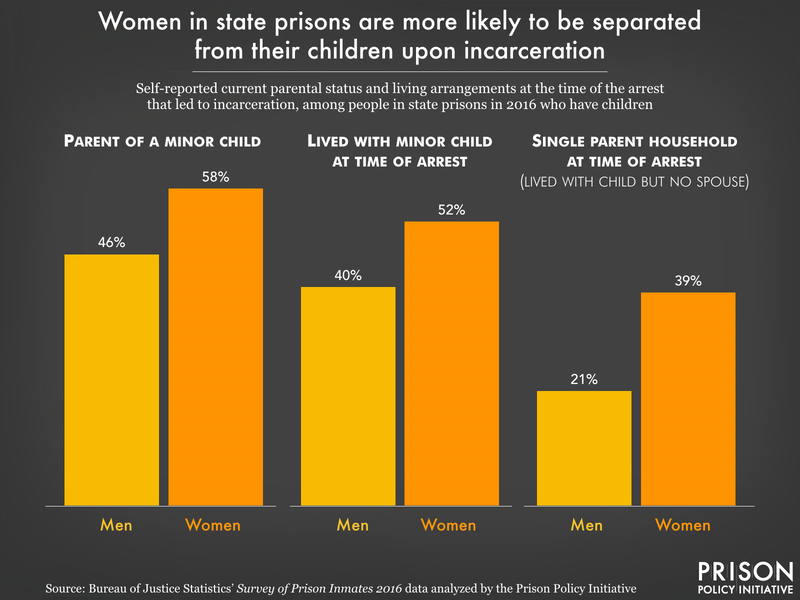
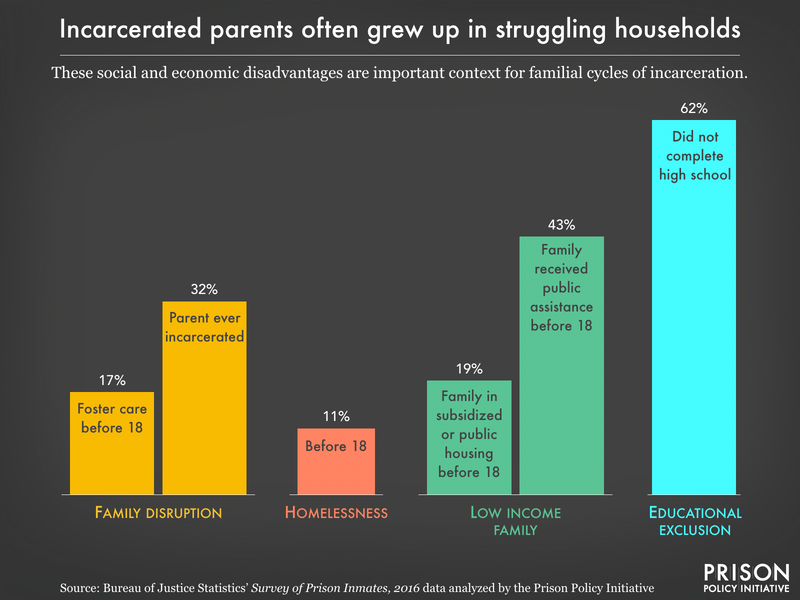
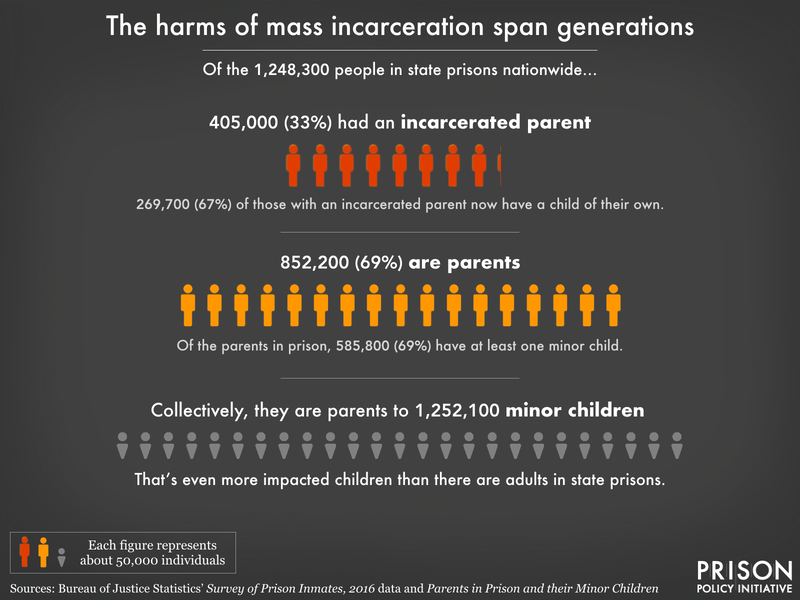
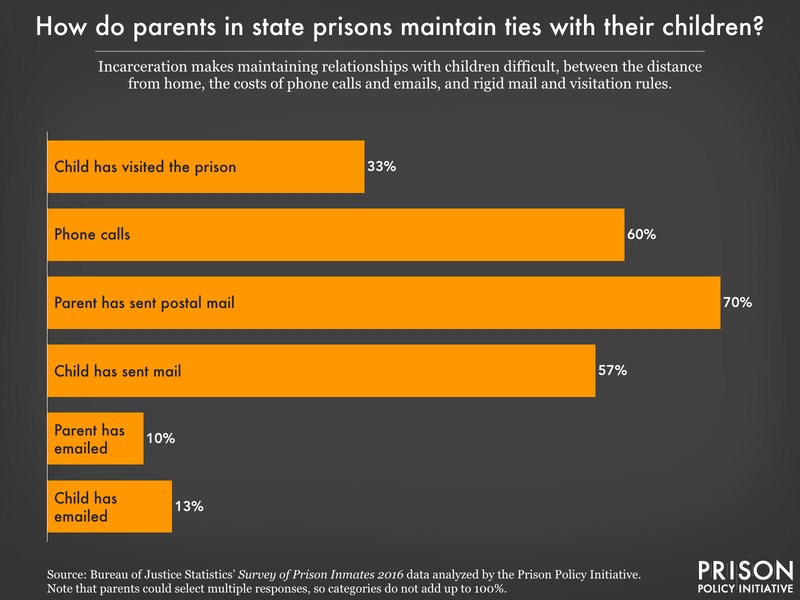
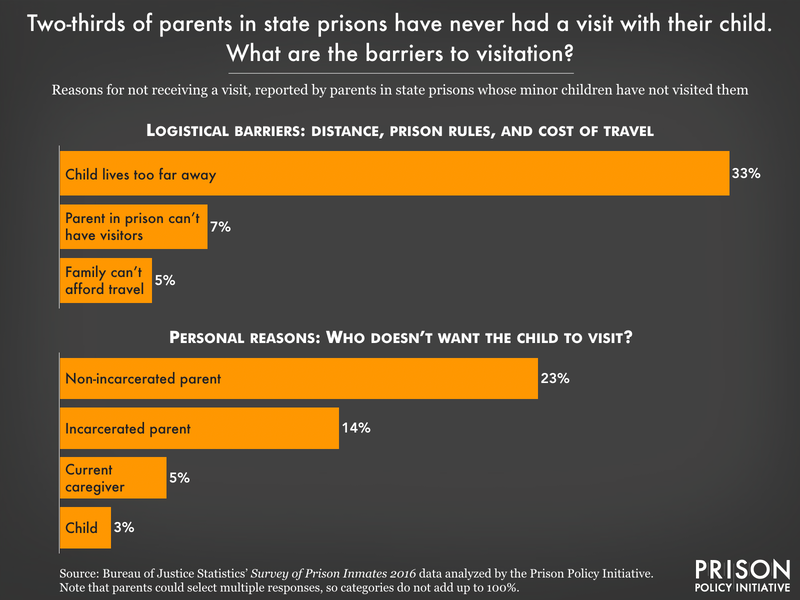




My husband is suffering now and has had several of his constitutional rights violated along with a few of mine but apparently it’s not important and they are above the law because no one will even acknowledge me when I ask for help.